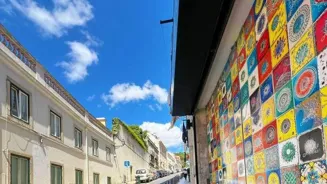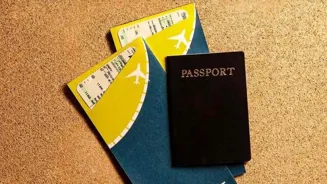Mastering Transportation in Foreign Cities: Your Ultimate Guide to Hassle-free Commuting. Dive in for expert tips!
Traveling to a new country is always exciting, but figuring out how to get around can be
a bit of a headache, innit? Different cities have different systems, different rules, and sometimes, language barriers can make things even more tricky.
But don't worry, we're here to give you the lowdown on navigating transportation in foreign cities like a pro. From understanding public transport to weighing the pros and cons of ride-sharing apps, this guide will help you plan your commute like a boss.
Pre-planning is key, as this might involve checking the peak and off-peak hours for fares.
Research transportation options before travel for efficient planning
Before you even pack your bags, do a little research on the transportation options available in the city you're visiting. Is there a well-developed metro system like in Delhi or Chennai? Or are buses the primary mode of public transport?

Some cities are very walkable, while others require you to rely on taxis or ride-sharing services. Websites like Rome2Rio are excellent for comparing different routes and modes of transportation between two points, giving you an idea of the price and travel time involved.
Also, download relevant transport apps to figure out the best options to use.
Knowing local lingo is vital for travelers. Ask locals, use maps, and learn basic phrases
Understanding the local lingo can be a lifesaver. Simple phrases like "Where is the bus stop?" or "Does this train go to [destination]?" can make a huge difference. Many cities have tourist information centers that provide maps and transportation guides in multiple languages.

Don't hesitate to ask for help from locals; most people are happy to point you in the right direction. Learning how to read a basic map and understand signage can also be incredibly beneficial. Remember to keep a phrase book or translation app handy.
Try to learn some basic phrases such as "Thank you", "Excuse me", etc.
Public transportation tips for budget-conscious travelers
Public transportation is often the most affordable way to get around, especially for budget-conscious travelers. Metro systems, buses, trams, and ferries can all be great options, depending on the city. However, it's important to understand how the system works before you hop on board.
Check if you need to purchase a special travel card or if you can pay with cash or a contactless payment method. Research the different zones or fare classes and make sure you have the correct ticket or pass for your destination.
Keep an eye out for announcements and be aware of your surroundings to avoid getting lost or missing your stop. Remember to be aware of the rush hour and plan your time accordingly.
Use ride-sharing apps cautiously; check legality, safety, and costs
Ride-sharing apps such as Uber and Ola are available in many cities around the world, offering a convenient alternative to taxis. However, it's important to be aware of the local regulations and safety precautions.
Check if the app is legal and licensed in the city you're visiting, and always verify the driver's identity before getting into the car. Sharing your ride details with a trusted friend or family member is also a good idea.
Additionally, be aware of surge pricing during peak hours or in high-demand areas. This can significantly increase the cost of your ride.
Walking and cycling are great for city exploration, with safety tips
Walking and cycling are excellent options for exploring a new city at your own pace, especially if you're interested in soaking up the local atmosphere and discovering hidden gems.
Many cities have pedestrian-friendly zones and dedicated bike lanes, making it safe and enjoyable to get around on foot or two wheels. Some cities also offer bike-sharing programs, allowing you to rent a bike for a short period of time.
Be sure to wear comfortable shoes and dress appropriately for the weather. Always be aware of your surroundings and follow traffic rules and regulations. Check if the sidewalks are friendly and safe to walk in.
Consider tourist pass for savings on transport & attractions
Consider purchasing a tourist pass. Many cities offer tourist passes that provide unlimited access to public transport for a certain period of time, along with discounts on attractions and activities.
These passes can be a great value if you plan on using public transport frequently and visiting multiple tourist sites. Compare the cost of the pass with the individual fares you would otherwise pay and see if it makes sense for your travel itinerary.
Stay safe by being vigilant in public spaces
Pay attention to safety. Always be aware of your surroundings, especially in crowded areas or at night. Keep your belongings secure and avoid displaying expensive jewelry or electronics.
If you're taking a taxi or ride-sharing service, make sure the driver is licensed and the vehicle is in good condition. Avoid walking alone in dimly lit or unfamiliar areas.
Understand local driving rules when renting a car
Learn about the local driving rules and customs, especially if you plan on renting a car. Traffic regulations can vary significantly from country to country, and it's important to be aware of the local laws to avoid accidents or fines.
Be prepared for different road signs and speed limits, and remember to drive on the correct side of the road. Parking can also be a challenge in some cities, so be sure to research parking options and regulations before you go.
Research accessibility options
If you or someone in your travel group has mobility issues, it's essential to research the accessibility options available in the city. Check if public transport is wheelchair-accessible and if there are ramps or elevators at train and metro stations.
Look for accessible taxis or ride-sharing services, and inquire about accessible accommodation options.
Prepare for transport delays; stay informed and plan ahead
Be prepared for delays and disruptions. Public transport can sometimes be subject to delays or disruptions due to unforeseen circumstances such as maintenance, accidents, or strikes. Stay informed about any potential disruptions and plan alternative routes or modes of transportation if necessary.
Download a transportation app that provides real-time updates and alerts on train and bus schedules.










